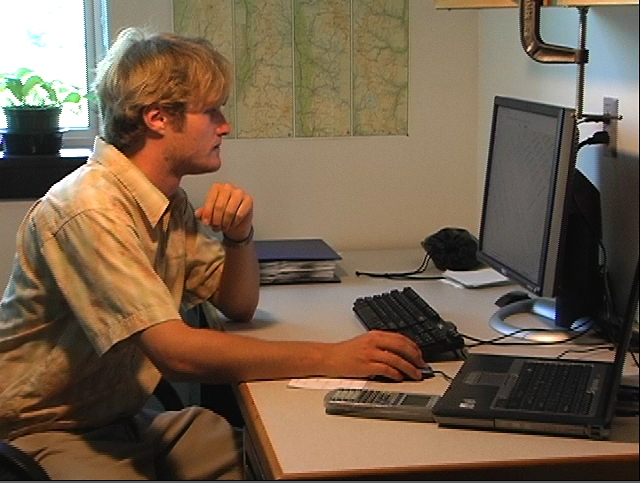Researchers' high-tech mapping offers new insights on Holocaust [video]

By Thomas Brant ‘10
Researchers at Middlebury College are joining forces with scholars from other universities around the world to provide new insights into one of the darkest chapters in human history — the extermination of approximately six million Jews during the Holocaust. Using geographical information systems, or GIS, Associate Professor of Geography Anne Knowles and eight other researchers are combining geography and history to map the Holocaust at every scale, from the individual experiences of prisoners and guards to the development of the concentration camp system across Europe.
| VIDEO: Prof. Anne Knowles and student researchers describe their project. (3:16) |
According to Knowles, the geographic approach to studying the Holocaust has never been attempted to such an extent. “This has never been done in a systematic way before,” she says. “There are a few geographers who have looked at the landscapes of the Holocaust, for example museums or former concentration camp sites. But we are the first group of scholars who have tried to combine geography and history to map the Holocaust.”Using GIS software, Knowles and three recent Middlebury graduates are working on two separate parts of the project. One goal is to create a map of various sites involved in the Holocaust throughout Europe-everything from factories to concentration camps. At the same time, the team is creating a digital reconstruction of the Auschwitz concentration camp. The digital model will be used to perform what Knowles calls “visibility analysis,” which will enable the researchers to view the camps the way prisoners or guards would have viewed them during the Holocaust. Such an analysis could reveal new details about camp life when compared with the extensive records kept by Nazi officials.
“You place yourself on a digital landscape, and ask the GIS to tell you what you can see from here,” Knowles explains. “That’s a key historical question. What could SS guards observe, and what was hidden from their view? Where were the safe zones, and where was one most vulnerable?”
So far, the two-year project has been a trial period to evaluate the use of GIS techniques to study the Holocaust. Alberto Giordano, an associate professor of geography at Texas State University, is working closely with Knowles on the project, which is funded by the National Science Foundation. Also important to the project’s success is its partnership with the United States Holocaust Memorial Museum’s Center for Advanced Holocaust Studies in Washington, D.C., which plans to use findings from the research on its website and in its archives.
The complex project has already provided rich research opportunities for students. Alex Yule, a 2009 graduate from Newton, Mass., is one of three former Middlebury students working with Knowles on the project. A self-described data geek, Yule first became interested in mapping the Holocaust after taking a class with Knowles last spring. He has been struck by what it means to examine such a devastating episode in human history. “Part of what makes this project so interesting is that there’s a moral weight to this topic,” Yule said.
Yule’s contribution to the project includes creating a series of digital animations based on detailed records from the Holocaust Memorial Museum that show where and when concentration camps were opened and closed during the Holocaust, as well as other sites where massive exterminations of Jews took place. For people who stop by the GIS lab at McCardell Bicentennial Hall where Yule is working, seeing large red dots that represent massacres flashing on his computer screen can be a startling way to think about the atrocities of the Holocaust.
“People would walk by and they’d stop and just stare,” Yule says. “They’d be mesmerized and they just couldn’t look away, because it was a map of Lithuania with these red dots that popped up every few seconds, and the size of the dot was proportional to the number of people who died. You know that every time a dot flashes on the screen, it represented thousands of people being murdered.”
Meanwhile, Chester Harvey is creating a digital reconstruction of Auschwitz, which will allow researchers to examine the horrors of the Holocaust on a much more local scale. Harvey, a 2009 graduate from Calais, Vt., is working with another scholar involved in the project, DePaul University Professor of Art and Architecture Paul Jaskot, to identify different areas of use within the Auschwitz concentration camp. Using extraordinarily detailed records obtained from Auschwitz and the Holocaust Memorial Museum, Harvey is trying to recreate the experiences of Nazi SS guards and prisoners.
One of the benefits of collaborating with historians is the ability to use GIS to its full potential. Harvey says the project is a great example of cooperation between academic disciplines, because those working with GIS provide the historians with geographical perspective, while the historians provide Knowles and her team with historical background.
“Geography is a fairly interdisciplinary subject, and this is a really interdisciplinary project,” Harvey explains. “Essentially, the historians are asking geographers to help them put more of a spatial framework on their study of the Holocaust.”
Toral Patel, a 2009 graduate from El Dorado Hills, Calif., the fourth member of Knowles’ team, is working with Yule to create a database of Holocaust sites, including concentration camps.
Findings from the project will be documented in a book of essays that will summarize what the researchers have found so far, as well as in journals of Holocaust studies and geography, according to Knowles. The team will also send findings from the GIS database to the Holocaust Memorial Museum, where they will be saved in the archives and posted on the Museum’s website.
“We hope that our work will become a model for good historical GIS, not just on the Holocaust but more generally,” Knowles says.

